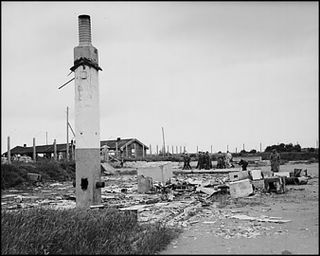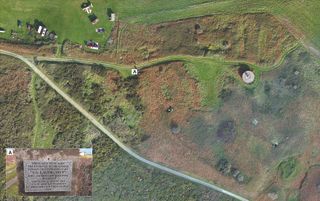Hidden atrocities of Nazis at concentration camp on British island finally come to light
Official accounts describing horrific conditions were hidden for decades.

A Nazi concentration camp on one of the British Channel Islands was the site of terrible atrocities that were downplayed in official reports after the end of World War II. Now, a new investigation reveals details that were kept hidden from the public for decades.
During WWII, the island of Alderney — part of an archipelago in channel waters between France and the United Kingdom — held the only Nazi concentration camps built on British land. There, inmates endured brutal treatment, including hard labor, beatings and starvation; but the full extent of what they suffered was not widely known even after the war ended.
Recently, archaeologists pieced together the story of Alderney's Sylt camp by examining declassified satellite images and exploring ruined buildings at the site. They created the first map of the camp, which was built by the Nazis in 1942 and used first as a forced labor camp for political prisoners and then as a concentration camp, researchers reported.
Related: Flying saucers to mind control: 22 declassified military & CIA secrets
The northernmost of the British Channel Islands, Alderney measures about 3 miles (5 kilometers) long and1.5 miles (2.4 km) wide. Sylt was originally constructed there to house 100 to 200 prisoners, about 20% of which died of poor treatment during the first year, according to a study published online yesterday (March 30) in the journal Antiquity.
Approximately 1,000 more people were transferred to the camp in 1943 — far more than Sylt was built to accommodate.
Around that time, prisoner supervision was handed over to a Nazi paramilitary group called "Totenkopfverband" (Death's Head Unit). Testimonies from Sylt survivors described 12-hour days of heavy construction work and little food, and guards who would beat the prisoners "with everything they could lay their hands on," according to the study.
Sign up for the Live Science daily newsletter now
Get the world’s most fascinating discoveries delivered straight to your inbox.
But as Germany's hold on Europe weakened, the Nazis began systematically destroying their own records regarding Sylt and other concentration camps, to hide the evidence of their crimes. Sylt closed in 1944, and after the war's end, British authorities on Alderney and the mainland conducted approximately 3,000 interviews with camp survivors, witnesses and German officers. Their official report wasn't released publicly until 1981, and it softened the worst of the details to quell rumors about the "death camp" in the British Channel, the scientists wrote in the study.

Mapping the site
Experts returned to Sylt in 2010 to evaluate the site and create the first reconstructions of the camp using archaeological methods, to better understand the inmates' living and work conditions. They visited the island, clearing vegetation and examining the camp's few remaining structures; they also used a remote-sensing method known as light detection and ranging, or lidar, to survey the former camp from above and map differences in elevation that would indicate where buildings once stood and how they were constructed.
Related: Images: Missing Nazi diary resurfaces
Their maps and 3D digital models showed that the prisoners' barracks were poorly built and unable to keep out the wind and cold. The buildings would also have provided only about 5 feet (1.5 meters) of living space per person, resulting in severe overcrowding. These findings corroborate witness testimony about outbreaks of lice and typhus, which would have spread quickly among people who were living in uncomfortably close quarters under unhygienic conditions, the authors said.
By comparison, according to the research, the Nazi guards lived comfortably, in buildings made of reinforced concrete surrounded by stone walls "to protect them from the weather and air raids," the study authors wrote.

According to Nazi records, only 103 people died at Sylt of "faulty circulation" or "heart failure," according to preprinted death certificates that the camp provided to Alderney doctors. But the recent discovery of mass graves on the island suggests that at least 700 people perished at Sylt; these new findings will help to ensure that their stories won't be forgotten, the study authors wrote.
"This work has shed new light on the German occupation of Alderney and, crucially, the experiences of the thousands of forced and slave laborers who were sent there," said lead study author Caroline Sturdy Colls, a professor of conflict archaeology and genocide investigation at Staffordshire University in the United Kingdom.
"Historical, forensic and archaeological approaches have finally offered the possibility to uncover new evidence and give a voice to those who suffered and died on Alderney so many years ago," Colls said in a statement.
- Understanding the 10 most destructive human behaviors
- 9 absolutely evil medical experiments
- Photos: The flying bombs of Nazi Germany
Originally published on Live Science.
OFFER: Save at least 53% with our latest magazine deal!
With impressive cutaway illustrations that show how things function, and mindblowing photography of the world’s most inspiring spectacles, How It Works represents the pinnacle of engaging, factual fun for a mainstream audience keen to keep up with the latest tech and the most impressive phenomena on the planet and beyond. Written and presented in a style that makes even the most complex subjects interesting and easy to understand, How It Works is enjoyed by readers of all ages.

Mindy Weisberger is an editor at Scholastic and a former Live Science channel editor and senior writer. She has reported on general science, covering climate change, paleontology, biology, and space. Mindy studied film at Columbia University; prior to Live Science she produced, wrote and directed media for the American Museum of Natural History in New York City. Her videos about dinosaurs, astrophysics, biodiversity and evolution appear in museums and science centers worldwide, earning awards such as the CINE Golden Eagle and the Communicator Award of Excellence. Her writing has also appeared in Scientific American, The Washington Post and How It Works Magazine.

